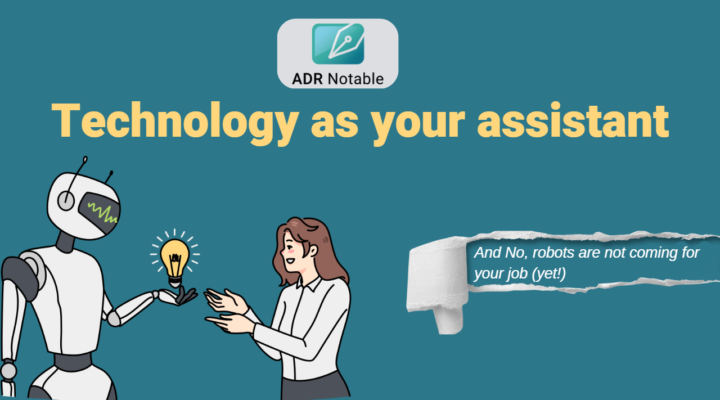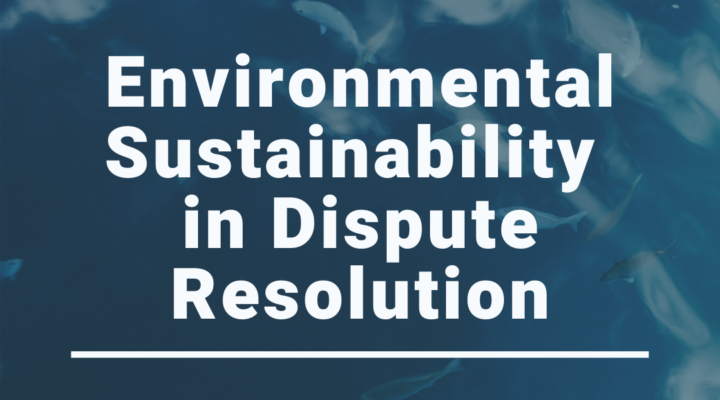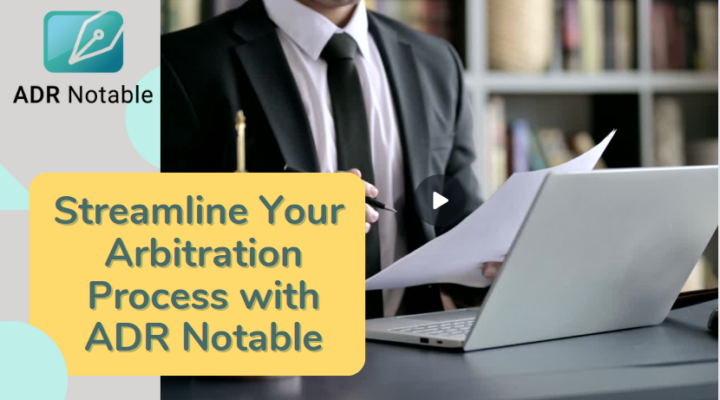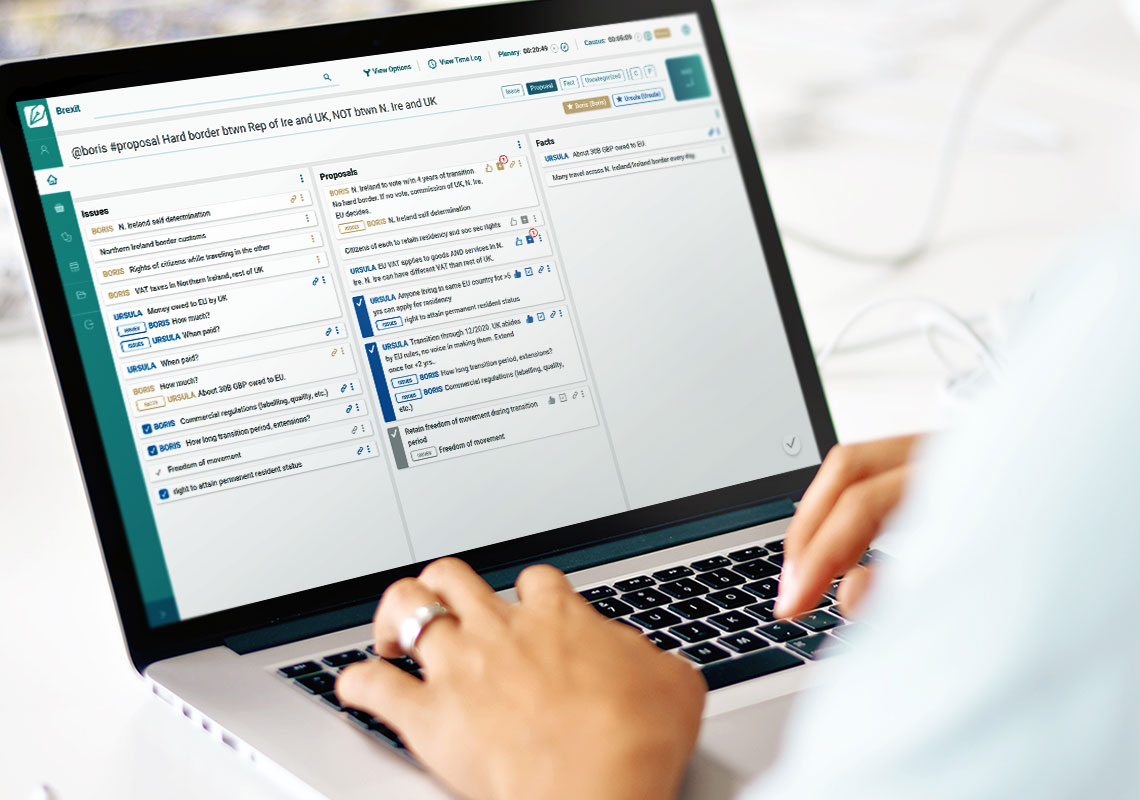Have a More Organized Mediation Practice with ADR Notable
Before you employ the uniquely human skills of a great mediator, you have to run a business. For businesses of every size, “get more organized” is a common New Year’s resolution. If your business is mediation, ADR Notable can help you have a more organized mediation practice this year.
A quick internet search for “get more organized at work” generates tips like:
- Find a pattern to your workflow
- Create a to-do list
- Make sure everything has a home
But how do you implement such tips to have a more organized mediation practice?
Find a Pattern to Your Workflow
All businesses have workflows or processes, often with a specific sequence. These workflows should be followed as best practices, either for ethics compliance or simply because they are efficient. After many conversations with mediators, we can diagram the mediator workflow as shown below.
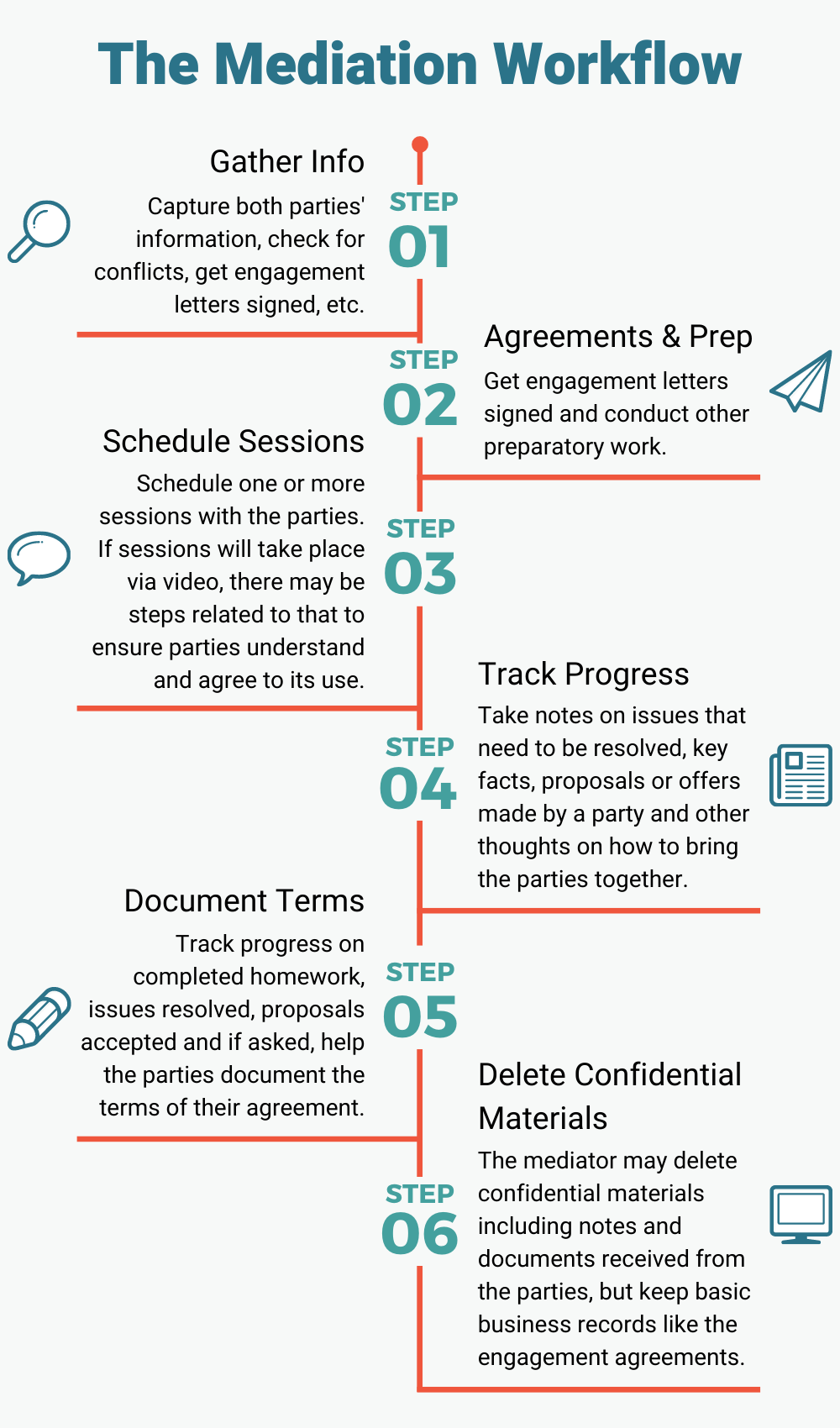
The 6 Steps of the Mediation Workflow
- The first thing that likely happens for a new case is contact from one party of the party’s counsel. The mediator needs to capture that party’s information, get the other party’s information, and check for conflicts.
- The mediator then gets engagement letters signed, arranges for compensation, and conducts other preparatory work that varies based on the type of matter. This preparatory work could include assigning “homework” to help the parties prepare for discussions or receiving pleadings or other documents from the parties.
- At this point, the mediator is ready to schedule one or more sessions with the parties. If sessions will take place via video, there may be related steps to ensure parties understand and agree to the use of video in-session.
- After that administrative process, the mediator can really get to work. The mediator speaks with the parties to build trust, understand the issues and interests at stake, and consider tactics to facilitate the parties’ efforts to find common ground. In working with the parties, most mediators find it useful to take notes, often including issues that need to be resolved, key facts, proposals or offers made by a party, and other thoughts the mediator may have on how to bring the parties together.
- If things progress as one hopes, the mediator tracks progress on completed homework, issues resolved, and proposals accepted. The mediator can also, if asked, help the parties document the terms of their agreement.
- As a final step, the mediator may delete confidential materials including notes and documents received from the parties, but keep basic business records like engagement agreements.
How Does ADR Notable Help the Mediation Workflow?
ADR Notable was designed specifically for mediators. The tool reflects this workflow, seamlessly integrating one step into the next. For instance, the system imports the party information you gathered in Step 1 into the Noteboard. In the Noteboard, you can easily organize notes or even tag them to identify which party originated each item. Any notes identified as “proposals” in the Noteboard can be marked as agreed or accepted with just a click. After reaching agreement on an item, that item is automatically moved to the next step. At that point you can edit the proposals into full sentences and add details to share with the parties as part of the final agreement.
To put it simply: every step in the mediator’s workflow is managed from a single, integrated software platform, keeping your mediation practice organized at every step of the mediation process and helping your mediation gain momentum towards a resolution.
Create a To-Do List
Whether you call it a to-do list or a checklist, these tools are great for getting (and staying!) organized. The mediator’s workflow (above) lends itself well to the use of checklists, ensuring each of the steps is completed, consistently, in every case. Checklists are so simple, yet so effective.
As Atul Gawande, the author of the bestselling book “The Checklist Manifesto” said:
“Checklists turn out…to be among the basic tools of the quality and productivity revolution in aviation, engineering, construction – in virtually every field combining high risk and complexity. Checklists seem lowly and simplistic, but they help fill in for the gaps in our brains and between our brains.”
Even pop culture picked up the theme. Former talk show host Jon Stewart once commented, “I watch a lot of astronaut movies…mostly Star Wars. And even Han and Chewie use a checklist.”
How Does ADR Notable Help Mediators Stay Organized with Checklists?
Guided by such notable experts as Han Solo and Chewbacca, ADR Notable incorporates process flow checklists into the architecture of our software platform. In ADR Notable, you can create your own checklist or use one of our built-in models, helping you have a more organized mediation practice.
Imagine, for instance, the most obvious use: a case intake checklist appended to every case with each of the steps in the mediator workflow above. Every time you open a case, you know exactly which administrative tasks are complete and which still need attention. There’s no more trying to remember if the counter-party returned the engagement agreement. No more scouring your email to determine if you scheduled a session. When you use ADR Notable and you receive the engagement agreement or schedule a session, you check it off on the checklist.
Still not convinced you should use checklists? Steven Levitt (University of Chicago economist and co-author of the Freakonomics books) said:
“No matter how expert you may be, well-designed checklists can improve outcomes.”
Time and time again, research shows that organization improves when using checklists. Specifically, there are two clear benefits to using checklists:
- You are more likely to complete all of the steps you list on the checklist.
- You will be more adept at managing the creative or unexpected events occurring around the usual process.
Make Sure Everything Has a Home
The third (and final) major organization tip for mediators is to have some place to put everything you might need. Think about how you organize your own mediation practice and individual cases. Within a single case, you need to store:
- your own documents (like an opening statement outline);
- standard forms or reference materials;
- business records (like signed engagement agreements);
- documents you receive from parties or experts related to the case;
- your own substantive notes taken during sessions or in preparation;
- administrative notes;
- homework for the parties, and more.
How do you keep all of these items organized so you can easily reference them? The key is to have a place where any piece of information related to the case can easily be filed, found, and accessed later. Most important? These items need to be securely stored.
How Does ADR Notable Help Mediators Organize Documents?
ADR Notable has a place for everything. From party names and contact information through every note or document of any kind, ADR Notable helps you easily capture information and receive documents. The Library function is also intuitive, keeping information where you expect to find it and where you might need to access it.
For example, you can load and store standard language, clauses, or form agreements in ADR Notable’s Library feature. This Library is accessible from the main menu or from the Term Sheet Builder, so you can find and insert a standard clause with just two clicks of the mouse, right where you need it!
ADR Notable not only helps you have a more organized mediation practice by having a place for everything, but it also keeps all of those important items stored securely in the cloud. That means if your computer’s hard drive fails, there’s no need to fret. You can log into ADR Notable from any device to access your case files. Storing your documents in the cloud by using ADR Notable is even more secure than storing those items locally on your own computer; in ADR Notable, the data is encrypted while being transmitted and while being stored. Even if you haven’t updated your virus protection on your own computer lately, any items you store in your ADR Notable Library are automatically protected.
Still wondering how ADR Notable can help you improve your mediation practice’s security? Check back later this month for a security-centric blog post, written by our Chief Product Officer, Noah!
What organization tips do you use in your mediation practice? Let us know via Twitter!


